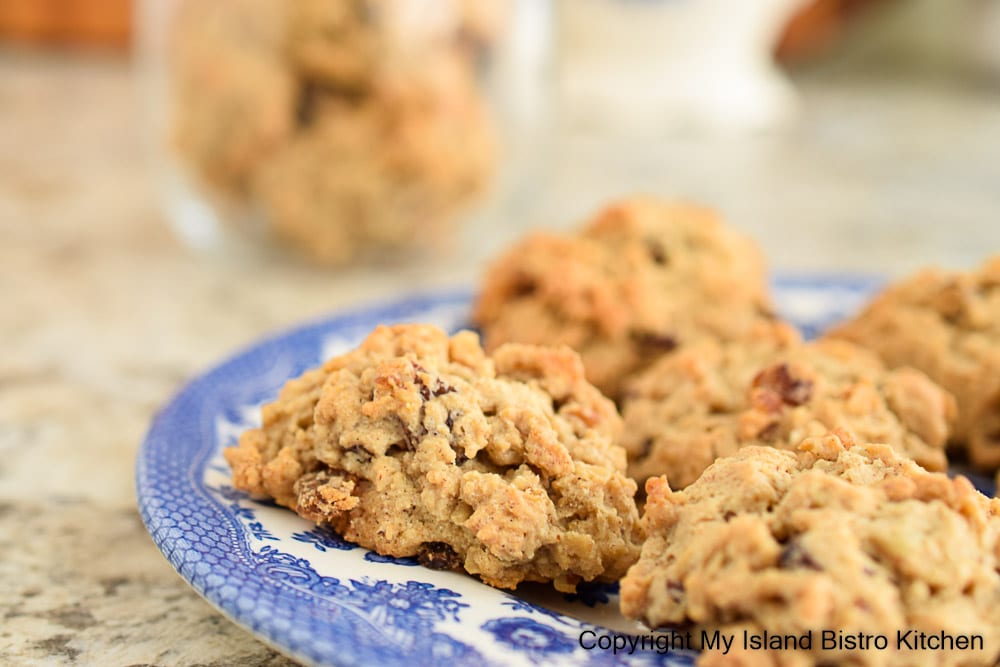
These old-fashioned Oatmeal Raisin Drop Cookies are a cookie jar favorite. Filled with plump raisins and pecans, the cookies have a delicious flavor profile owing to the combination of warm spices. The cookies have a lovely soft texture with a short, tender crumb and the key to keeping them soft is not to overbake them.
In this blog post, in addition to providing a tasty cookie recipe, I am also going to explain a couple of reasons why bakers might find cookie dough for drop cookies spreading and baking flat when soft, puffy cookies are anticipated. One reason might be the type of fat content in the recipe and another reason could be the temperature of the cookie dough when it goes into the oven.
Butter and Shortening – The Best of Both Worlds Combination For Many Cookie Recipes
My recipe for Oatmeal Raisin Drop Cookies calls for both butter and shortening. Both products are considered fats and, of course, we know that fat adds flavor, moisture, and texture to baked goods but have you ever wondered why some recipes call for both butter and shortening or even just shortening like my Chocolate Drop Cookies, for example?
While butter is often the preferred fat in baked goods for the rich buttery flavor it imparts (it’s hard to argue that point!), it can also be the cause of some types of cookies spreading while they bake and becoming somewhat flat and hard.
According to the Dairy Farmers of Canada website, in order to be labeled as butter, Canadian-produced butter must consist of at least 80% fat (though some brands may have a slightly higher percentage than that). What’s in the remaining 20%? Well, the majority of it is water.
As we know, water, when it heats up, produces steam. When liquid/steam meets up with flour, gluten production is underway. While gluten strands are desired in some recipes (e.g., bread), they aren’t always desirable in all baked goods. This is because overproduced gluten can lead to a tough textured baked good. In the case of cookies made with only butter (which also has liquid content in addition to its fat content), the crumb texture may not be as soft and slightly chewy as desired.
In addition, butter has a lower melting point which means it starts to melt quickly when the baked goods are placed in the oven, before they have a chance to set and develop their shape. This causes the cookie dough to quickly spread out flat instead of rising into lovely puffy cookies. A flat, spread out cookie obviously bakes harder/more crispy, particularly on the edges.
Shortening, on the other hand, is a solid flavorless vegetable oil fat with no water content. If there is no water to create steam, less gluten will be formed and, ta-da, the cookies are likely to have a softer, more tender texture. Additionally, shortening has a higher melting point than butter so it gives the dough a longer chance to set and establish itself before the fat melts and spreads the cookies out, again helping to create cookies that can be expected to have a higher rise and a softer and more tender texture than if baked with butter as the sole fat ingredient. Shortening, which has no flavor, will not affect the flavor profile of baked goods other than, of course, they will not have a buttery taste.
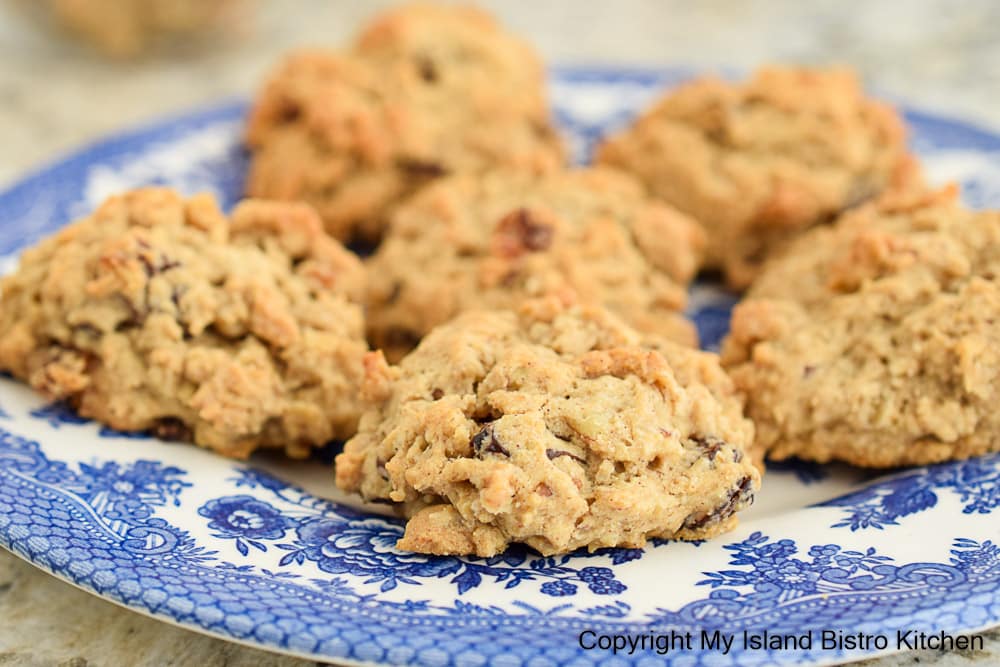
When making certain kinds of cookies, like these Oatmeal Raisin Drop Cookies, for example, the combination of both butter and shortening is desirable for the contributions each makes to the end result of yielding an overall better quality cookie. The butter contributes the rich, buttery flavor and the shortening allows the cookies to rise better, hold their shape during baking, and yield a lovely tender crumb. Best of both worlds! Now, you know why some cookie dough recipes call for some butter and some shortening.
This is not to say that lovely cookies can’t be made with all butter or all shortening. They can. It depends on what the end goal is for the cookies. For certain cookie recipes, and depending on the crumb texture and shape desired, using part butter and part shortening may produce a more desirable end result in the baked goods. My advice for best results is to rely on a trusted, tested recipe from a reputable recipe developer and use the fat content called for in the recipe. If the recipe developer has done a good job, the ingredients have been specifically chosen and tested to yield the best all-round quality cookie possible.

Refrigerating Cookie Dough
Like many drop cookie doughs, the dough for Oatmeal Raisin Drop Cookies benefits from being refrigerated for at least 1½ – 2 hours, basically long enough to firm up the butter and shortening that were earlier brought to room temperature so they could be creamed for the cookie dough.
While we know it is important to have ingredients at room temperature to blend them well together, room temperature cookie dough going into a hot oven is often a cause of cookies spreading and becoming thin or flat and hard instead of puffy, soft, and chewy. This is especially true of cookies that have a high fat butter content.
The softened butter in room temperature cookie dough will promptly melt as soon as the cookies go in the oven, causing the cookies to quickly spread out before they have a chance to form structure and shape and start baking. However, if the dough has been chilled for at least 1½ – 2 hours, the butter (as well as vegetable shortening, if used) has had a chance to firm up, and cold, firm butter/shortening takes longer to melt in the oven. This delay gives the cookies a chance to rise up instead of immediately spreading out. As a result, the cookies begin to bake, create structure, and are able to hold their shape before the butter, in particular, breaks down and flattens and spreads them out. I do not recommend skipping the dough chilling step for these Oatmeal Raisin Drop Cookies.
If the dough is particularly hard when it comes out of the refrigerator to the point that it can’t be scooped or spooned without chibbling it, let it rest at room temperature for 10 – 15 minutes. Do not, however, bring the dough back to room temperature and soften as that will defeat the objective of having the butter firm up in the dough before the cookies enter the hot oven and start spreading out.
There can be several reasons for why cookies spread and bake hard/crispy (e.g., wrong ratio of ingredients, omitted or substituted ingredients, oven temperature, etc.) but two of the more common reasons are the wrong choice of fat content for the particular cookie recipe and putting room temperature cookie dough into the oven. I recommend using recipes from tested sources and following the ingredient content and amounts the recipe developer has indicated and with which the recipe has been tested.
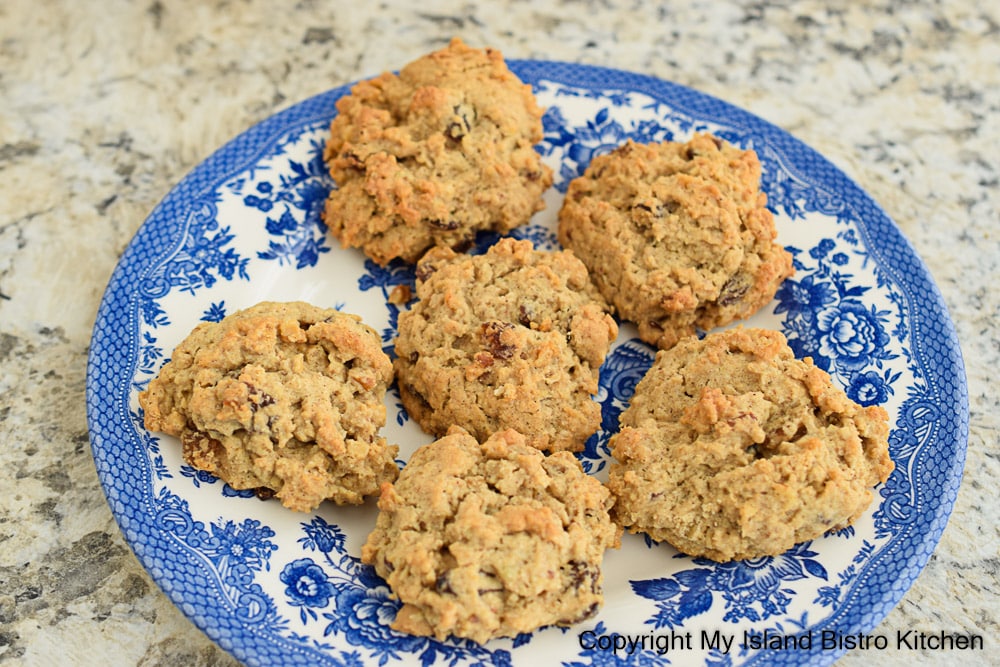
Pro Tips for Making These Oatmeal Raisin Drop Cookies:
- Start with room temperature ingredients as they blend best.
- Use the sour cream (no substitutions):
– It adds moisture to the cookie dough without thinning the dough as milk, for example, would
– The acid content of the sour cream activates the baking soda allowing its leavening powers to help the cookies rise
– It helps to tenderize gluten strands which will result in more tender-textured, soft cookies - Don’t overmix the cookie dough as this will stimulate gluten formation resulting in hard, tough textured cookies. Once the dry ingredients are added to the liquid content of the recipe, mix very little – basically only enough that the dry ingredients are barely incorporated. This is because, once the flour meets up with liquid, gluten production is underway and overstirring/overmixing encourages that in a negative way.
- Refrigerate the cookie dough for 1½ – 2 hours to allow the butter and shortening content to firm up before the cookies go in the oven. This will help keep them from spreading out flat before they have a chance to develop their shape and start baking.
- In order to maintain soft-textured cookies, don’t overbake the cookies. Depending on the size of the cookies, these cookies should bake in the 12-14 minute range. However, they will be sufficiently baked when they have puffed up, have the appearance of the tops starting to look dry, edges are set, and the cookies are slightly tanned. Note that every oven bakes differently so the 12-14 minutes of baking time is just a gauge as you know your oven best.
- Rotate the cookie sheet half-way through the baking time to ensure all cookies have even baking.
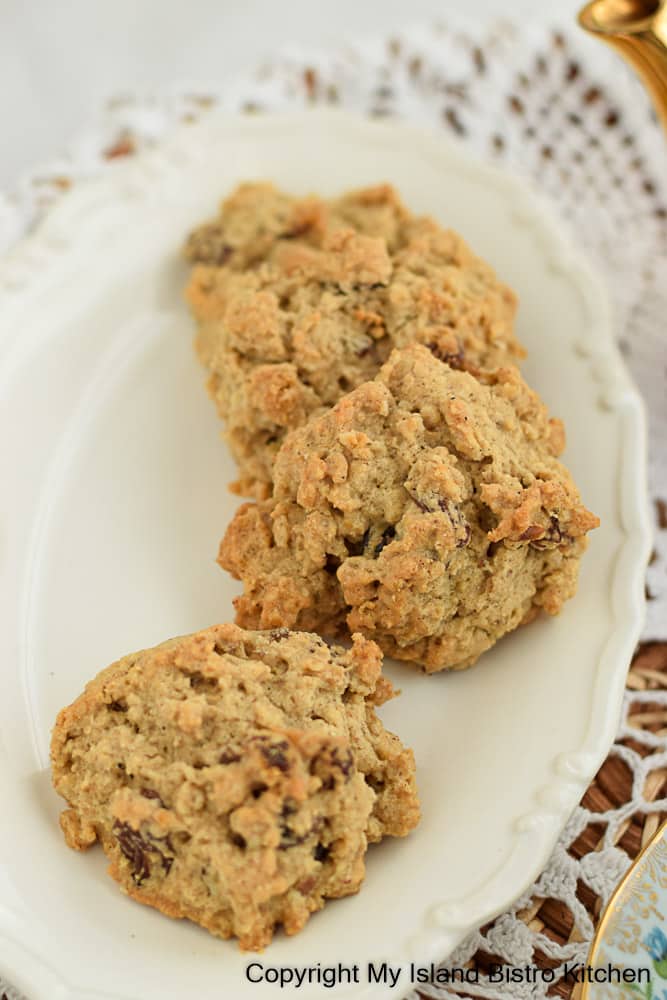
You may also enjoy these other drop cookie recipes from My Island Bistro Kitchen:
Hearty Hermit Cookies
Zucchini Chocolate Chip Drop Cookies
Christmas Fruitcake Drop Cookies
Cranberry and Eggnog Drop Cookies
Chocolate Drop Cookies
[Printable recipe follows at end of post]
Oatmeal Raisin Drop Cookies
Ingredients:
½ cup butter, softened at room temperature
½ cup shortening, room temperature
½ cup light brown sugar, packed
¼ cup granulated sugar
2 large eggs, room temperature
1/3 cup + 1 tbsp sour cream, room temperature (no substitutions)
1¾ tsp pure vanilla extract
2 cups all-purpose flour
1 tsp baking powder
¾ tsp baking soda
½ tsp salt
1 tsp cinnamon
1 tsp nutmeg
¼ tsp cloves
1/8 tsp allspice
2 cups quick cooking rolled oats (not instant)
1¼ cups sultana raisins
2/3 cup chopped pecans
Method:
Bring butter, shortening, eggs, and sour cream to room temperature.
In medium-sized bowl, sieve or sift the dry ingredients.
Combine the rolled oats, sultana raisins, and pecans in separate bowl.
In bowl of stand mixer fitted with paddle attachment, cream the butter and shortening at medium-high speed until smooth and creamy. With mixer set at low speed, gradually add the sugars then beat on medium speed for approximately 1½ – 2 minutes, stopping to scrape down sides of bowl, if and as necessary. Add eggs, one at a time, beating to incorporate after each addition. Add the sour cream and vanilla and beat just to incorporate. Do not overbeat mixture.
With speed of mixer set to low, gradually add the dry ingredients and beat mixture just until ingredients are combined. Do not overmix. Mix in the rolled oats, raisins, and nuts just until incorporated.
Cover bowl tightly and refrigerate for about 1½ – 2 hours to firm up butter and shortening content in dough.
Position oven rack in center of oven and preheat oven to 350°F. Line baking sheet(s) with parchment paper.
Scoop up dough by rounded tablespoonful and transfer to prepared baking sheet, spacing cookies about 2” apart. Bake for 12-14 minutes (depending on size of cookies), or until cookies have puffed up, have the appearance of the tops starting to look dry, edges set, and the cookies are lightly tanned. Rotate cookie sheet(s) at the halfway point during baking. To maintain a soft texture, do not overbake cookies. Remove cookies from oven and let rest on cookie sheet for 2-3 minutes before transferring to wire rack to cool.
Yield: Apx. 3 dozen cookies (depending on amount of dough used per cookie and size of cookie desired)
If you have made this recipe and enjoyed it and/or wish to share it with your friends and family, please do so on social media but be sure to share the direct link to this posting from my website.
Connect with My Island Bistro Kitchen on Social Media
Join the Facebook page for My Island Bistro Kitchen: https://www.facebook.com/MyIslandBistroKitchen/
Follow “the Bistro” on “X” (formerly Twitter): https://twitter.com/PEIBistro/
See the drool-worthy gallery of mouth-watering food photos from My Island Bistro Kitchen on Instagram: https://www.instagram.com/peibistro/
Follow “the Bistro” on Pinterest at https://www.pinterest.ca/peibistro/ and pin the Pinterest-ready photo at the end of this posting to your favorite Pinterest boards!
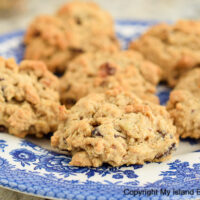
Oatmeal Raisin Drop Cookies
Ingredients
- ½ cup butter, softened at room temperature
- ½ cup shortening, room temperature
- ½ cup light brown sugar, packed
- ¼ cup granulated sugar
- 2 large eggs, room temperature
- 1/3 cup + 1 tbsp sour cream, room temperature (no substitutions)
- 1¾ tsp pure vanilla extract
- 2 cups all-purpose flour
- 1 tsp baking powder
- ¾ tsp baking soda
- ½ tsp salt
- 1 tsp cinnamon
- 1 tsp nutmeg
- ¼ tsp cloves
- 1/8 tsp allspice
- 2 cups quick cooking rolled oats (not instant)
- 1¼ cups sultana raisins
- 2/3 cup chopped pecans
Instructions
- Bring butter, shortening, eggs, and sour cream to room temperature.
- In medium-sized bowl, sieve or sift the dry ingredients.
- Combine the rolled oats, sultana raisins, and pecans in separate bowl.
- In bowl of stand mixer fitted with paddle attachment, cream the butter and shortening at medium-high speed until smooth and creamy. With mixer set at low speed, gradually add the sugars then beat on medium speed for approximately 1½ - 2 minutes, stopping to scrape down sides of bowl, if and as necessary. Add eggs, one at a time, beating to incorporate after each addition. Add the sour cream and vanilla and beat just to incorporate. Do not overbeat mixture.
- With speed of mixer set to low, gradually add the dry ingredients and beat mixture just until ingredients are combined. Do not overmix. Mix in the rolled oats, raisins, and nuts just until incorporated.
- Cover bowl tightly and refrigerate for about 1½ - 2 hours to firm up butter and shortening content in dough.
- Position oven rack in center of oven and preheat oven to 350°F. Line baking sheet(s) with parchment paper.
- Scoop up dough by rounded tablespoonful and transfer to prepared baking sheet, spacing cookies about 2” apart. Bake for 12-14 minutes (depending on size of cookies), or until cookies have puffed up, have the appearance of the tops starting to look dry, edges set, and the cookies are lightly tanned. Rotate cookie sheet(s) at the halfway point during baking. To maintain a soft texture, do not overbake cookies. Remove cookies from oven and let rest on cookie sheet for 2-3 minutes before transferring to wire rack to cool.
Recipe Notes
Yield: Apx. 3 dozen cookies (depending on amount of dough used per cookie and size of cookie desired)
[Copyright My Island Bistro Kitchen]
PIN ME TO PINTEREST!



